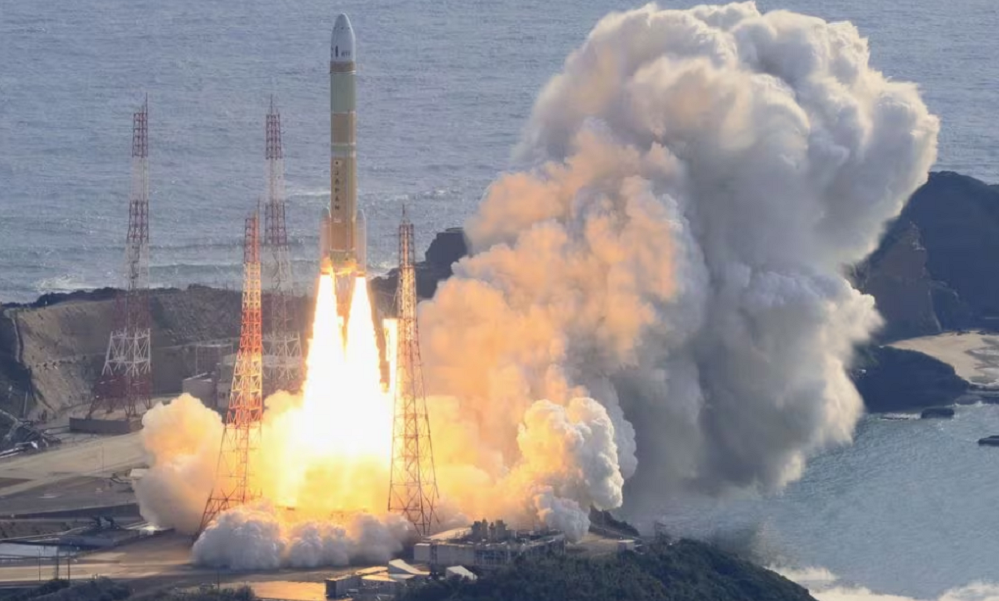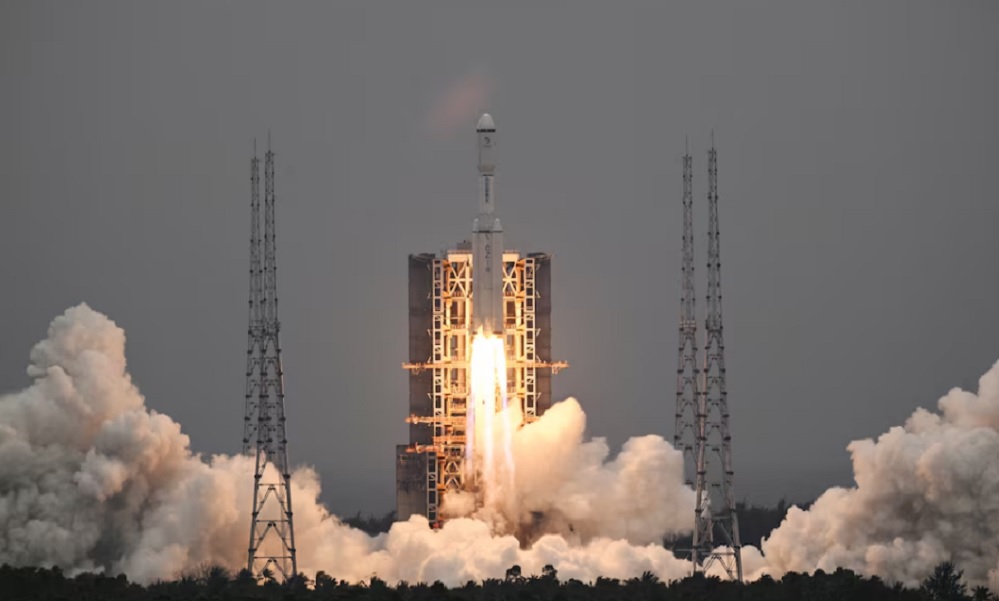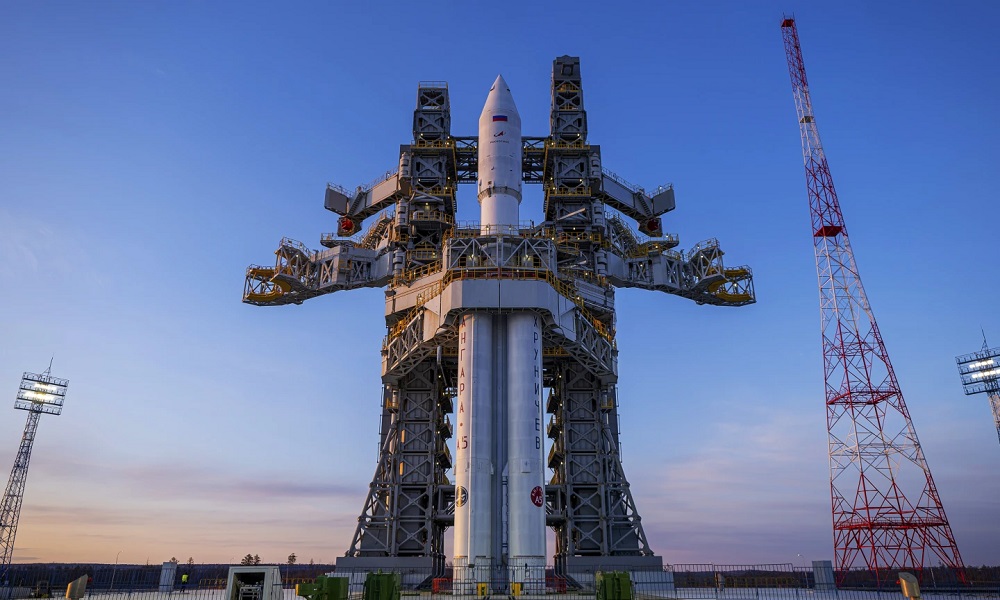Science & Technology
Japan successfully launches next-generation H3 rocket after failure last year

Japan successfully launched its new H3 flagship rocket on Saturday, putting its space programme back on track after multiple setbacks including the failure of the rocket’s inaugural flight last year.
The launch also marks a second straight win for the Japan Aerospace Exploration Agency (JAXA) after its lunar lander, SLIM, achieved a “pinpoint” touchdown last month and made Japan only the fifth country to put a spacecraft on the moon, Reuters reported.
A relatively small player in space by number of launches, Japan is seeking to revitalise its programme as it partners with ally the United States to counter China.
The H3 lifted off at 9:22 a.m. local time (0022 GMT) and after it successfully released a small satellite, jubilant scientists at the Tanegashima Space Center in southern Japan clapped, yelled and hugged each other.
The rocket also released a microsatellite and a dummy satellite during its flight of nearly two hours.
“The newborn H3 has just made its first cry”, JAXA project manager Masashi Okada, who has led the decade-long development of the new rocket, told a news conference.
“And we need to start preparing for the third H3 launch as soon as tomorrow.”
The H3 is due to replace the two-decade-old H-IIA, which is retiring after two more launches. Another failed flight would have seen Japan face the prospect of losing independent access to space.
The first launch in March ended up with ground control destroying the rocket 14 minutes after liftoff when the second-stage engine failed to ignite. JAXA listed three possible electrical faults in a review released in October but could not identify the direct cause.
Five months earlier, JAXA’s small rocket Epsilon had also failed to launch.
“So happy to see this incredible accomplishment in the space sector that follows on from the success of the SLIM moon landing,” Prime Minister Fumio Kishida said in a post on X.
The 63 m (297 ft) H3 is designed to carry a 6.5 metric ton payload and over the long-term, the agency wants to reduce per-launch cost to as low as five billion yen ($33 million) – half of what an H-IIA launch costs – by adopting simpler structures and automotive-grade electronics.
JAXA and primary contractor Mitsubishi Heavy Industries (7011.T), opens new tab hope those features will help them win launch orders from global clients.
“It’s taken some time for the program to get to this point but with this launch, they will be fielding inquiries from around the world,” said Ko Ogasawara, a professor at the Tokyo University of Science.
The Japanese government plans to launch about 20 satellites and probes with H3 rockets by 2030 for domestic use. The H3 is scheduled to deliver a lunar explorer for the joint Japan-India LUPEX project in 2025 as well as cargo spacecraft for the U.S.-led Artemis moon exploration program in the future.
Satellite launch demands have skyrocketed thanks to the rise of affordable commercial vehicles such as SpaceX’s reusable Falcon 9 and a number of new rockets are being tested this year.
Last month marked the successful inaugural flight of the United Launch Alliance’s Vulcan rocket, a joint venture between Boeing (BA.N), opens new tab and Lockheed Martin (LMT.N), opens new tab. The European Space Agency also plans to launch its lower-cost Ariane 6 for the first time this year.
Masayuki Eguchi, the head of Mitsubishi Heavy’s defence and space business, said the company has a long-term target of launching eight to ten rockets a year, which would boost its 50 billion yen space business sales by 20-30%.
That would require additional production capacity, he added, noting the company’s factories can currently only produce five to six H3 rockets a year.
Science & Technology
Apple loses top phonemaker spot to Samsung as iPhone shipments drop, IDC says

Apple’s (AAPL.O), opens new tab smartphone shipments dropped about 10% in the first quarter of 2024, hurt by intensifying competition by Android smartphone makers aiming for the top spot, data from research firm IDC showed on Sunday.
Global smartphone shipments increased 7.8% to 289.4 million units during January-March, with Samsung (005930.KS), opens new tab, at 20.8% market share, clinching the top phonemaker spot from Apple, Reuters reported.
The iPhone-maker’s steep sales decline comes after its strong performance in the December quarter when it overtook Samsung as the world’s No.1 phone maker. It’s back to the second spot, with 17.3% market share, as Chinese brands such as Huawei gain market share.
Xiaomi, one of China’s top smartphone makers, occupied the third position with a market share of 14.1% during the first quarter, read the report.
South Korea’s Samsung, which launched its latest flagship smartphone lineup – Galaxy S24 series – in the beginning of the year, shipped more than 60 million phones during the period.
Global sales of Galaxy S24 smartphones jumped 8%, compared to last year’s Galaxy S23 series during their first three weeks of availability, data provider Counterpoint previously said.
In the first quarter, Apple shipped 50.1 million iPhones, down from 55.4 million units it shipped same period last year, according to IDC.
Apple’s smartphone shipments in China shrank 2.1% in the final quarter of 2023 from a year earlier.
The drop underscores the challenges facing the U.S. firm in its third biggest market, as some Chinese companies and government agencies limit employees’ use of Apple devices, a measure that mirrors U.S. government restrictions on Chinese apps on security grounds.
The Cupertino, California-based company in June will hold its Worldwide Developers Conference (WWDC), where it will highlight updates to the software powering iPhones, iPads, and other Apple devices.
Investors are closely watching for updates on artificial intelligence development at Apple, which has so far spoken little about incorporating the AI technology into its devices. The company earlier this year lost the crown as the world’s most valuable company to Microsoft (MSFT.O), opens new tab, Reuters reported.
Science & Technology
China launch of relay satellite Queqiao-2 for lunar probe mission successful

China National Space Administration (CNSA) said on Friday its launch of a key signal relay satellite was a “complete success” and it would serve as the communication bridge for its future lunar probe missions for years to come, state media reported.
China launched the satellite Queqiao-2, which was named after a mythological bridge made of magpies, and two miniature satellites, Tiandu-1 and Tiandu-2, on March 20.
Queqiao-2 will be used as a communications bridge between the ground operations on earth and upcoming lunar probe missions on the far side of the moon until at least 2030.
The moon’s near side always faces earth. That means data transfers from the far side are impossible because there is no direct line of sight.
Queqiao-2 researcher and developer Xiong Liang described the satellite as “the main switch” of the whole fourth phase of lunar missions, according to state television CCTV.
“Only when the main switch is flipped on, all the communications can kick off,” Xiong said.
Queqiao-2 will orbit the moon and relay signals to and from the Chang’e-6 mission, which expected to be launched in May. The robotic Chang’e-6 probe will seek to retrieve samples from an ancient basin, acquiring lunar material from the moon’s hidden side for the first time.
Queqiao-2 will also be used as a relay platform for the Chang’e-7 lunar mission in 2026 and the Chang’e-8 mission in 2028.
The functions and performance of Queqiao-2 met mission requirements and it will be able to provide relay communication services for China’s lunar exploration projects and future lunar missions for China and other countries, said the CNSA, according to CCTV.
Queqiao-2 entered its targeted elliptical orbit on April 2 after a correction midway, near-moon braking and orbital manoeuvre around the moon, CNSA said.
The satellite has successfully communicated with Chang’e 4, which was the first spacecraft to perform a soft landing on the far side of the moon and is still carrying out its exploration mission. It also communicated with the Chang’e-6 probe while it is still on the ground earlier this month.
The successful launch of Queqiao-2 comes after the failed launch of another lunar spacecraft DRO-A/B satellites, which was intended to enter the moon’s distant retrograde orbit (DRO).
China has not released any information on whether or not the satellites can be retrieved.
(Reuters)
Science & Technology
Russia aborts planned test launch of new heavy-lift space rocket

Russian space officials on Tuesday aborted the test launch of a new heavy-lift rocket from its far-eastern launch pad.
The Angara-A5 rocket was scheduled to lift off from the Vostochny space launch facility at 0900 GMT Tuesday, but the launch was aborted two minutes before, AP reported.
Yuri Borisov, head of Roscosmos state space corporation, said the automatic safety system canceled the launch after registering a flaw in the oxidizer tank pressurization system.
He said the next launch attempt was set for Wednesday.
Tuesday’s launch was to be the fourth for the Angara-A5, a heavy-lift version of the new Angara family of rockets that has been developed to replace the Soviet-designed Proton rockets.
-

 Latest News3 days ago
Latest News3 days agoRashid Khan named AWCC’s brand ambassador
-

 Regional4 days ago
Regional4 days agoIranian president lands in Pakistan for three-day visit to mend ties
-

 Sport4 days ago
Sport4 days agoKolkata beat Bengaluru by one run in IPL as Kohli fumes at dismissal
-

 Sport4 days ago
Sport4 days agoACL: Aino Mina 3-0 Istiqlal Kabul; Attack Energy 3-0 Khadim
-

 Climate Change4 days ago
Climate Change4 days agoRescuers race to reach those trapped by floods in China’s Guangdong
-

 Business5 days ago
Business5 days agoAfghanistan, Kazakhstan to hold joint expo in Kabul
-

 World3 days ago
World3 days agoMalaysian navy helicopters collide in mid-air, 10 killed
-

 Sport3 days ago
Sport3 days agoJaiswal ton powers Rajasthan to big IPL win
























